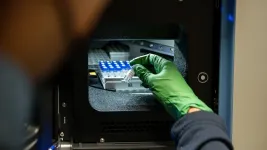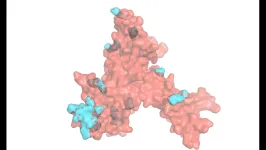(Press-News.org) How well you synchronize to a simple beat predicts how well you synchronize with another mind, according to a new Dartmouth study published in Scientific Reports.
Previous work has demonstrated that the pupil dilation patterns of speakers and listeners synchronize spontaneously, illustrating shared attention. The team set out to understand how the tendency to synchronize in this way may vary at the individual level and generalize across contexts, as it has been widely debated whether one form of synchrony bears any relationship to another.
“We were quite surprised to find that how well your pupils dilate and constrict to something as simple as a rhythmic beat would predict how well you attend in the same way as another person,” says lead author Sophie Wohltjen, who was a graduate student in psychological and brain sciences at Dartmouth at the time of the study and is now a postdoctoral researcher at University of Wisconsin-Madison. “What this suggests is that there may be some sort of underlying mechanism that can unite a lot of the different ways that we talk about synchrony.”
The research was comprised of two studies. In the first study, individuals listened to a series of tones and were asked to indicate which one was softer than the others while their pupil responses were tracked. Each individual completed this “oddball detection task” during nine separate sessions that were held on a different day and time for each session. The researchers found stable, individually-specific variation in the amount each person entrained to the oddball rhythm. Some people’s pupils dilated strongly in time with the beat, others less so, and however strongly a person synchronized one day predicted how strongly they synchronized the next.
In the second study, 82 individuals completed the oddball task once and also listened to audio recordings of four emotional stories while their pupil responses were tracked. The storytellers’ pupil dilations were recorded earlier when they read the stories. The researchers calculated the pupillary synchrony between the storyteller and listener and then compared this synchrony to how strongly the listener synchronized to the rhythmic beat of the oddball task.
The results demonstrate that the more someone entrained to the rhythmic beat of the task, the more likely they were to synchronize their pupils with those of the storyteller. As these individuals could not see the storyteller, pupillary synchrony could not be explained as simple visual mimicry. Instead, this synchrony was evidence that the storyteller and listener were attending to the story in the same way.
“Identifying that these two forms of synchrony—simple, metronomic entrainment and complex shared attention—are linked is really interesting, as it opens up all sorts of larger questions about why this tendency to synchronize varies between people,” says senior author Thalia Wheatley, the Lincoln Filene Professor in Human Relations and director of the Consortium for Interacting Minds at Dartmouth. “Do musicians synchronize their attention more easily with others? Why are some people super-synchronizers while others are unable to synchronize altogether? Do strong synchronizers find it easier to click with others? These are all questions we plan to investigate further,” says Wheatley.
“This simple measure of being able to entrain to a beat could have clinical implications for autism and other disorders, which are not only about having difficulty with social interaction but are also about timing,” adds Wheatley.
The research on synchrony to a beat builds on the team’s earlier work, which finds that making and breaking eye contact is linked to fluctuations of pupillary synchrony between conversation partners and makes conversation more engaging.
Wohltjen and Wheatley are available for comment at: wohltjen@wisc.edu and thalia.p.wheatley@dartmouth.edu.
###
END
Synchronizing to a beat predicts how well you get ‘in sync’ with others
2023-03-07
ELSE PRESS RELEASES FROM THIS DATE:
How high altitude changes your body’s metabolism
2023-03-07
SAN FRANCISCO, CA—March 7, 2023—Compared to those of us who live at sea level, the 2 million people worldwide who live above 4,500 meters (or 14,764 feet) of elevation—about the height of Mount Rainier, Mount Whitney, and many Colorado and Alaska peaks—have lower rates of metabolic diseases such as diabetes, coronary artery disease, hypercholesterolemia, and obesity.
Now, researchers at Gladstone Institutes have shed light on this phenomenon. They showed how chronically low oxygen levels, such as those experienced at high elevation, rewire how mice burn sugars ...
Endocrine Society elects Newell-Price as 2024-2025 President
2023-03-07
Endocrine Society members elected John Newell-Price, M.D., Ph.D., F.R.C.P., as its 2024-2025 President. He will serve as President-Elect for a year beginning in June 2023 before becoming President in June 2024.
Newell-Price is Professor of Endocrinology at the University of Sheffield in Sheffield, United Kingdom. He also is head of the endocrinology service at the Sheffield Teaching Hospitals NHS Foundation Trust and of the European Neuroendocrine Tumor Society at the hospital.
Newell-Price’s clinical expertise ...
Genetic and socioeconomic factors interact to affect risk of type 2 diabetes and obesity
2023-03-07
BOSTON – New research led by investigators at Massachusetts General Hospital (MGH), a founding member of Mass General Brigham (MGB), indicates that socioeconomic and genetic factors likely interact in an additive way to affect people’s risks of developing obesity and type 2 diabetes. The findings, which are published in Diabetes Care, suggest that interventions to improve socioeconomic deprivation may decrease metabolic diseases at the individual and community levels, especially among people with concomitant high genetic risk.
Genetic and socioeconomic factors—one intrinsic and unmodifiable and ...
Heart tissue heads to space to aid research on aging and impact of long spaceflights
2023-03-07
Note: Johns Hopkins Medicine researchers Deok-Ho Kim and Devin Mair will participate in a NASA teleconference for journalists on Tuesday, March 14, at 11 a.m. ET.
Johns Hopkins Medicine researchers are collaborating with NASA to send human heart “tissue-on-a-chip” specimens into space as early as March. The project is designed to monitor the tissue for changes in heart muscle cells’ mitochondria (their power supply) and ability to contract in low-gravity conditions.
The tissue samples will ...
Heart toggles between maintenance and energy-boost mode using ribosomes
2023-03-07
Researchers at the Centre for Genomic Regulation (CRG) in Barcelona have discovered a mechanism involving ribosomes which helps the heart toggle between a ‘regular maintenance mode’ for day-to-day function and an ‘energy-boost mode’ which aids recovery for high-demand situations including heart attacks. The findings are published in a ‘Breakthrough Article’ in the journal Nucleic Acids Research, a distinction awarded to studies that answer long-standing questions in the field.
Ribosomes are the molecular factories that manufacture proteins in all living cells. Historically, they have been ...
NYU Langone orthopedic surgeons present latest clinical findings & research at AAOS 2023
2023-03-07
Experts from NYU Langone Orthopedics will present their latest clinical findings and research discoveries at the 2023 American Academy of Orthopaedic Surgeons (AAOS) Annual Meeting, March 7 to 11, in Las Vegas.
Topics being presented include the following:
minimally invasive in-office needle arthroscopy to diagnosis and treat a common cause of chronic ankle pain
improving postoperative pain with intraoperative injections during hip fracture surgery
using an additional dose of dexamethasone to reduce postoperative opioid use for pain after knee replacement
“Our clinical teams continue to innovate and investigate how we can provide our patients with the best possible outcomes. ...
Teacher supports, guidance for elementary social studies education vary widely across U.S., report finds
2023-03-07
A new RAND Corporation report finds that the basic infrastructure to support elementary (grades K-5) social studies instruction – academic standards, accountability requirements, assessment programs – is inadequate in many states. Even where state-level infrastructure to guide teachers’ instruction is in place, its comprehensiveness and quality vary greatly.
Support and guidance at the district and school level to underpin social studies instruction are also lacking compared to other core academic ...
Electric vehicle batteries could get big boost with new polymer coating
2023-03-07
Scientists at Lawrence Berkeley National Laboratory (Berkeley Lab) have developed a conductive polymer coating – called HOS-PFM – that could enable longer lasting, more powerful lithium-ion batteries for electric vehicles.
“The advance opens up a new approach to developing EV batteries that are more affordable and easy to manufacture,“ said Gao Liu, a senior scientist in Berkeley Lab’s Energy Technologies Area.
The HOS-PFM coating conducts both electrons and ions at the same time. This ensures battery stability and high charge/discharge rates while enhancing battery life. The coating ...
Researchers identify key protein that promotes DNA repair and prevent cancer
2023-03-07
A research team, affiliated with UNIST has unveiled a key factor involved in the DNA damage response (DDR), homologous recombination (HR) and DNA interstrand crosslink (ICL) repair. According to the research team, their findings are expected to establish an effective control environment for chromosome instability (CIN), a major factor in cancer evolution, and further help combat malignant tumors .
Published in the January 2023 issue of Nucleic Acids Research, this breakthrough ...
FDA mandate to limit acetaminophen in acetaminophen-opioid medications is associated with reduced serious liver injury
2023-03-07
BIRMINGHAM, Ala. – A United States Food and Drug Administration mandate to limit the dosage of acetaminophen in pills that combine acetaminophen and opioid medications is significantly associated with subsequent reductions in serious liver injury, researchers report in the medical journal JAMA. The federal mandate was announced in 2011 and implemented in 2014.
“The FDA mandate that limits acetaminophen dosage to 325 milligrams per tablet in combination acetaminophen-opioid medications was associated with a significant and persistent decline in the yearly rate of hospitalizations and proportion per year of acute liver failure ...





